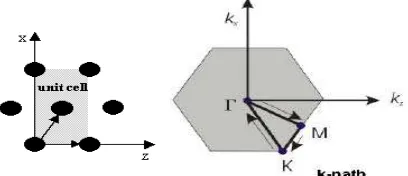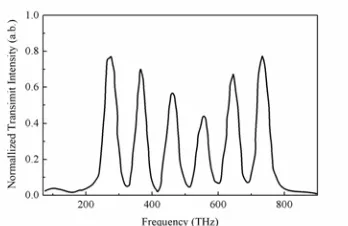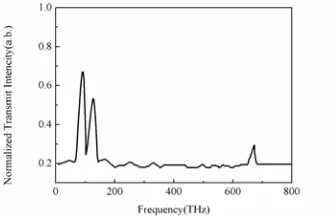DOI: 10.12928/TELKOMNIKA.v14i3A.4414 27
Investigation Effects of Filling Rate on the Bands Gaps
of Two Dimensional Photonic Crystals
Baohe Yuan*1, Qi Xu2, Linfei Liu3, Xiying Ma4 1,2,3
North China University of Water Resources and Electric Power, Zhengzhou 450011, China
4Shaoxing College of Arts and Sciences, Shaoxing 312000, Zhejiang Province, China
*Corresponding author, e-mail: yuanbaohe@ncwu.edu.cn
Abstract
The influences of the filling rate on the photonic band gap properties of the two dimensional hex photonic crystals are investigated using the finite-difference time-domain method. When the filling rate f varies from 0.227 to 0.735 reminding the refractive index as 5, the number of the photonic band gaps decreases from 5 to 2 bands, the width of the photonic band gap between the transmit peaks become narrow; but for larger f > 0.445, the transmit intensity is very low in the high frequency region, it can be consider as a larger photonic band gap region, the onset of this larger photonic band gap shifts toward low frequency. At the same time, the onset transmit peaks shift toward low frequency also. The simulation results show that the photonic band gap can be effectively changed by the filling rate.
Keywords: photonic crystal, photonic band gap, filling rate, finite-difference time-domain
Copyright © 2016 Universitas Ahmad Dahlan. All rights reserved.
1. Introduction
Photonic crystals (PCs) have gained much attention in the past decade due to the great applications in luminescence and communication fields [1-3]. A lot of efforts have been devoted to design materials so that can affect the properties of photons [4-5]. And striking progress has been achieved in three-dimensional (3D) photonic crystal fabrications from microwave to visible to obtain a complete photonic band gap (PBG) [6-7]. However, serious technological problems and high cost still restrict the applications of 3D materials especially in visible range [8-9]. Two-dimensional (2D) photonic crystal structures are the most advanced and fast developing areas owing to mature fabrication methods and envisioned broad applications [10-12]. The main factors that determine the properties of 2D photonic crystals are the refractive index contrast, the filling rate of materials in the lattice and the arrangement of the lattice elements [13-15]. Systematically investigate the action of refractive index and filling rate on PBG is necessary. Several methods, such as planer wave, transfer matrix and the finite-difference time-domain (FDTD), have been used to model the propagation of electromagnetic waves in photonic crystals and achieved many useful results [16-17]. However, plane wave cannot be used when the structure containing defects that break the periodicity and induce localized modes. Since FDTD method makes use of the periodicity of the lattice, it is perfectly well suited for band structure calculations [18-19].
In this work, the finite-difference time-domain (FDTD) is developed to examine the effect of the filling rate on PBG behavior of the hex lattice photonic crystals in the TE electromagnetic waves. The PCs transmit features of hex lattices have been simulated as the filling rate f ranging from 0.227 to 0.735.
2. Theoretical Modeling
process of PBG for TE mode electromagnetic radiation. The radius of the air sphere is 0.25 m, the lattice constant is 1 m, and the refractive index of the medium is 5.
The 2D TE electromagnetic mode of the photonic crystals are taken to propagate in x-z plane, Hx, Ey, Hz nonzero components propagate along z, transverse field varies along x in lossless media and the magnetic field parallels to the y axis, Maxwell’s equations take the following form:
)
(
1
x
H
z
H
t
E
y x z
,z
E
t
H
x y
01
,x
E
t
H
z y
01
(1)where =0r is the dielectric permittivity, r is the dielectric constant of the medium, and
the refractive index is n0
r , 0 and 0 is the vacuum dielectric constant and the magnetic permeability, respectively.Figure 1. The Schematic diagram of the fcc (a) and hex (b) lattices. The radius of the air sphere and the lattice constant a are 0.25 m and 1 m, respectively
The total set of numerical equation (1) takes the from:
)] , 2 / 1 ( ) , 2 / 1 ( [ )] 2 / 1 , ( ) 2 / 1 , ( [ ) , ( ) , ( 2 / 1 2 / 1 2 / 1 2 / 1 1 k i H k i H x t k i H k i H z t k i E k i E n z n z n x n x n y n y (2) )] , ( ) 1 , ( [ ) 2 / 1 , ( ) 2 / 1 , ( 0 2 / 1 2 / 1 k i E k i E z t k i H k i
Hxn xn yn ny
(3))] , ( ) , 1 ( [ ) , 2 / 1 ( ) , 2 / 1 ( 0 2 / 1 2 / 1 k i E k i E x t k i H k i H n y n y n x n
x
(4)The superscript n labels the time steps while the indices i and k label the space steps and x and z along the x and z direction, respectively. This is the so-called Yee’s numerical method applied to the 2D TE case [18, 20-21]. It uses central difference approximation for the numerical derivatives in space and time, both having second order accuracy. Typically, the sampling in time is selected to ensure numerical stability of the algorithm, 10 to 20 steps per wavelength are needed, and the time step is determined by the Courant limit:
The power of TE mode incidence in the both 2 D lattice photonic crystals is 1 V/m with the wavelength of 1.9 m.
)
)
/(
1
)
/(
1
/(
1
c
x
2z
2t
3. Results and Discussion
Figure 2 shows the normalized transmit intensity verses the frequency as filling rate f=0.227 and the refractive index as 5 of a hex lattice for TE mode normal incidence. The transmit spectrum is consist of five proportional spacing transmit bands, the transmit intensity is very low between each transmit band, this is the so-called PBG region in which the TE mode cannot propagate [22, 23]. Therefore, there are five PBG regions located at 295-347, 385.6-447, 482-534, 569-621 and 662-711 THz. The width of these 5 PBGs is 52, 62, 52, 52 and 49 THz determined from the FWHM (full width at half maximum) of the bands. It indicates that the five PBG are almost equidistance.
Figure 2. The normalized transmit intensity verses frequency spectrum of a hex lattice with f =0.227 and refractive index as 5 for TE mode at normal incidence. There are five PBG
bands
In Figure 3 shows the transmit intensity verses the frequency as the filling rate f=0.327. Similar to Figure 2, there are also five PBGs that located at 340-382, 447-486, 548-586.6, 645-683 and 749-791 THz, respectively, the width of them is 42, 39, 38.6, 38 and 42 THz, respectively. Compare with Figure 2, the width of PBG bands decrease about 10 THz. At the same time, the transmit spectrum turns up fine structure, each transmit band contains double transmit peaks. The intensity of the transmit peaks decreases from 0.85 for the first peak down to 0.52 for the fifth peak, showing a reducing by 0.32.
Figure 3. The normalized transmit spectrum of a hex structure for f =0.327. Five PBGs are located at 340-382, 447-486, 548-586.6, 645-683 and 749-791 THz, respectively, the width
of them is 42, 39, 38.6, 38 and 42 THz, respectively
the first one is centered at 205 THz, and the other is the larger region for frequency over 330 THz. Compare with Figure 2 and Figure 3, the number of PBG decreases from 5 to 2, at the same time, the larger PBG band shift to high frequency region, the onset transmit peak sharply shift towards low frequency.
Figure 4. The normalized transmit spectrum of a hex for f =0.445. There are two PBG regions, the first one is centered at 205 THz, and the other is large region for frequency over 330 THz
In the case of f=0.581 and 0.735, the corresponding transmit spectrum is shown in Figure5 and Figure6. These two spectra is very similar, both contain two transmit peaks; there is a small PBG between the two peaks. Similar to Figure 4, when frequency is over 200 THz in Figure 5 and 140 THz in Figure 6, the transmit intensity is very low, it can be considered as PBG regions. This indicates that most frequency region is hold up by PBG for larger f, the TE electromagnetic wave for frequency over 200 THz and 140 THz may not propagated in these hex lattices, most electromagnetic wave is reflected or absorbed by the lattice. In addition, the onset transmit peaks sharply shift towards low frequency.
Figure 5. The normalized transmit spectrum of a hex for f =0.581. There are two PBG regions, the first one is centered at 105 THz, and the other is large region for frequency over 200 THz
In view of the gaps of above hex structures, the existence of multiple photonic band gaps is rather interesting. With the filling rate increasing, the number of PBG bands decreases, more and more frequency region is hold up by PBG, this tendency offers more freedom in designing multi-channel photonic crystals devices.
4. Conclusion
The influences of the filling rate on the PBG properties of 2D hex photonic crystal are investigated using the FDTD method. With the filling rate increasing, the number of PBG bands decreases from 5 to 2 bands, for larger f (>0.445), the transmit intensity is very low in high frequency region, it can be consider as a larger PBG region. At the same time, the onset transmit peaks shift toward low frequency. It shows that the photonic band gap can be effectively influenced by the filling rate. The changes in hex lattice are especially interesting and helpful in designing multi-channel PCs devices.
References
[1] Yablonovitch E. Inhibited spontaneous emission in solid state physics and electronics. Phy. Rev. Lett.
1987; 5: 2059-2062.
[2] Vlasov YA, Luterova K, Pelant I, Honerlage B, Astratov VN. Optical gain of CdS quantum dots embedded in 3D photonic crystals.Thin Solid Films. 1998; 318(4): 93-95.
[3] Dowling JP, Scalora M, Bloemer MJ, Bowden CM. The photonic band edge laser: A new approach to gain enhancement. J. Appl. Phys. 1994; 75(2): 1896-1899.
[4] Ohnishi D, Okano T, Imada M, Noda S. Room temperature continuous wave operation of a surface-emitting two-dimensional photonic crystal diode laser. Optics Express. 2004; 12(8): 1562-1568. [5] Ferrando A, Zacarés M, Córdoba PF, Monsoriu A. Spatial soliton formation in photonic crystal fibers.
Optics Express. 2003; 11(5): 452-459.
[6] Ye YH, Le Blanc F, Hache, Truong VV. Self-assembling three-dimensional colloidal photonic crystal structure with high crystalline quality. Appl. Phys. Lett. 2001; 78(1): 52-54.
[7] Chutinan A, Noda S. Highly confined waveguides and waveguide bends in three-dimensional photonic crystal. Appl. Phys. Lett. 1999; 75(12): 3739-3741.
[8] Noda S. Three-dimensional Photonic Crystals Operating at Optical Wavelength Region. Physica B. 2000; 279(2): 142-149.
[9] Vlasov YA, Astratov VN, Karimov OZ, Kaplyanskii AA, Bogomolov VN, Prokofiev AV. Existence of a photonic pseudogap for visible-light in synthetic opals. Phys. Rev. B. 1997; 55(5): 13357-11360. [10] Zoorob ME, Charltona MDB, Parker GJ, Baumberg JJ, Netti MC. Experimental investigation of
photonic crystal waveguide devices and line-defect waveguide bends.Mate. Sci. and Eng. B. 2000; 74(7): 168-174.
[11] Rakhshani MR, Mansouri-Birjandi MA. Tunable Channel Drop Filter using Hexagonal Photonic Crystal Ring Resonators. TELKOMNIKA Indonesian Journal of Electrical Engineering. 2013; 11(1): 513-516.
[12] Kácik D, Turek I, Martincek I, Canning J, Issa NA, Lyytikäinen K. Intermodal interference in a photonic crystal fibre.Optics Express. 2004; 12(8): 3465-3470.
[13] Mohammad EJ, Abdullah GH. TM-Polarization One-Dimensional Photonic Crystal Design.
International Journal of Advances in Applied Sciences. 2013; 2(3): 165-170.
[14] Krauss Thomas F, Richard M, De La Rue. Optical and confinement properties of two-dimensional photonic crystals. Prog. Quan. Elect. 1999; 23(1): 51-96.
[15] Ghadrdan M, Mansouri-Birjandi MA. All-Optical NOT Logic Gate Based on Photonic Crystals.
International Journal of Electrical and Computer Engineering (IJECE). 2013; 3(4): 478-482.
[16] Centeno E, Felbacq D. Light propagation control by finite-size effects in photonic crystals. Phys. Lett. A. 2000; 269(1):165-169.
[17] Modinos A, Stefanou N, Yannopapas V. Applications of the layer-KKR method to photonic crystals.
Optics Express. 2001; 8(1): 197-202.
[18] Meade RD, Brommer KD, Rappe AM, Joannopoulos JD. Electromagnetic Bloch waves at the surface of a photonic crystal. Phys. Rev. B. 1991; 44(11): 10961-10964.
[19] Rakhshani MR, Mansouri-Birjandi MA. Wavelength Demultiplexer using Heterostructure Ring Resonators in Triangular Photonic Crystals. TELKOMNIKA Indonesian Journal of Electrical Engineering. 2013; 11(4): 1721-1724.
[20] Yee KS. Numerical solution of initial boundary value problems involving Maxwell's equations in isotropic media. Antennas Propagation. 1966; 17(5): 302-307.
[22] Feng SS, Shen LF, He SL. A two-dimensional photonic crystal formed by a triangular lattice of square dielectric rods with a large absolute band gap. Acta Physica Sinica (in Chinese). 2004; 53(5): 1540-1545.


